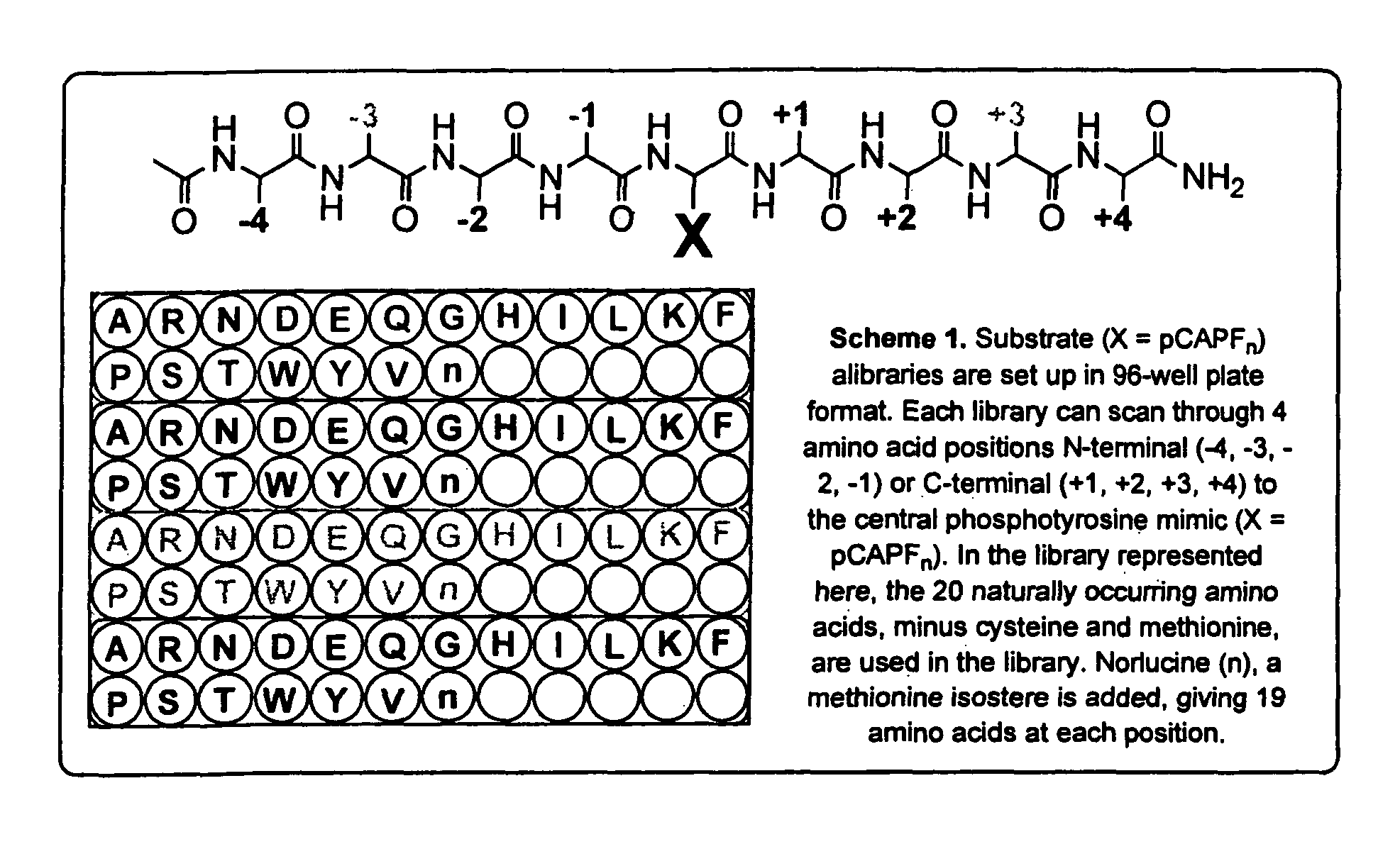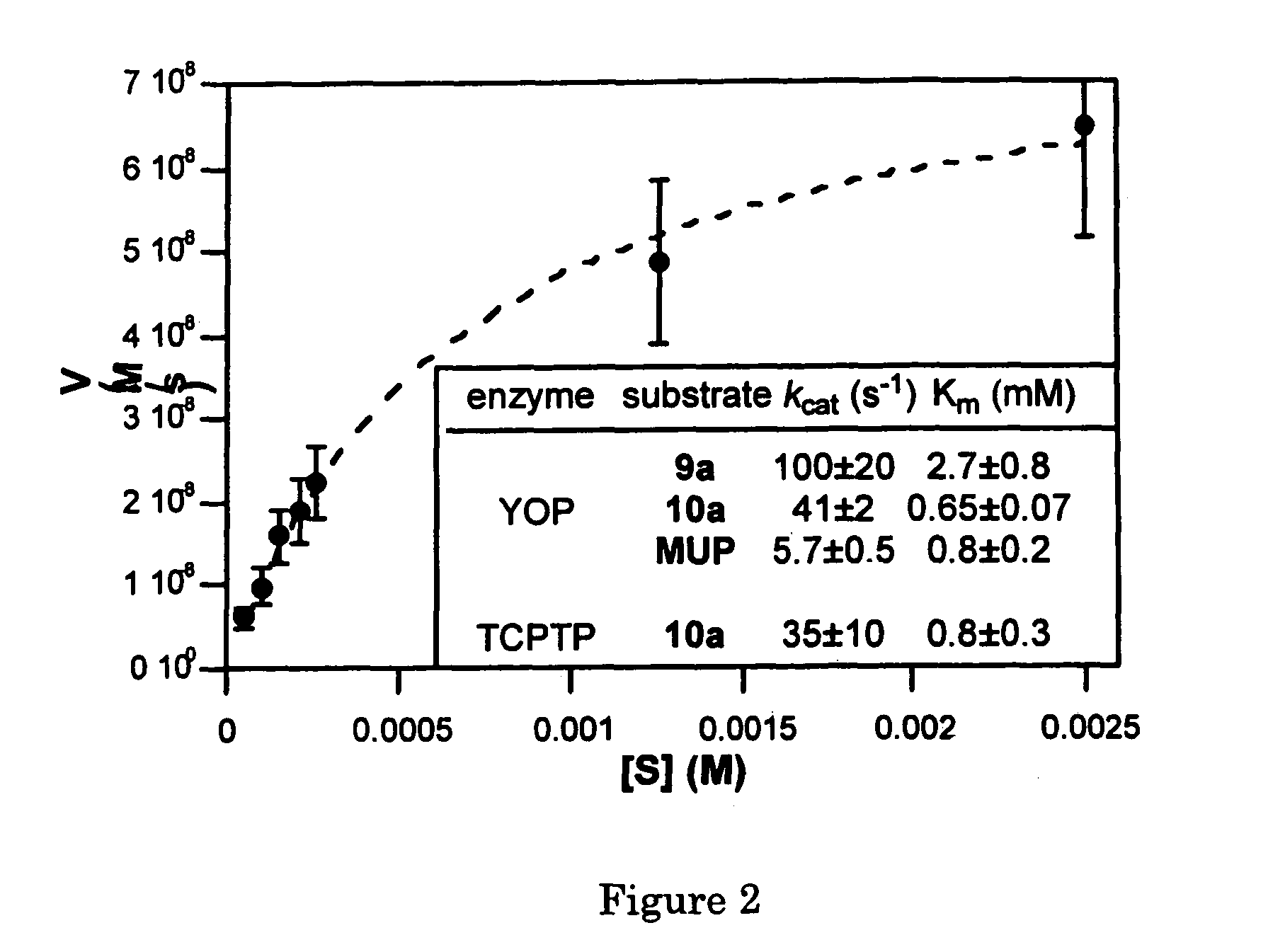Coumarin-based amino acids for use in enzyme activity and substrate specificity assays
a technology of which is applied in the field of coumarin-based amino acids for use in enzyme activity and substrate specificity assays, can solve the problems of not being able to act as a reporter, not being suitable only as standalone substrates or extrinsic fluorescent labels, and not being able to achieve the effect of enzymatic activity probes, excellent thermal and chemical stability, and easy incorporation into peptides
- Summary
- Abstract
- Description
- Claims
- Application Information
AI Technical Summary
Benefits of technology
Problems solved by technology
Method used
Image
Examples
example 1
Synthesis of 2-(9H-Fluoren-9-ylmethoxycarbonylamino)-succinic acid 4-tert-butyl ester 1-(2,2,2-trichloro-ethyl)ester (2)
[0162]A solution of compound 1 (0.4115 g, 1 mmol), 2,2,2-trichloroethanol (1.3 equiv) and DMAP (0.5 equiv) in anhydrous dichloromethane was cooled to −78° C. To this mixture, DCC (1.3 equiv) was added and the reaction mixture was allowed to stir at −78° C. for 2 h. Upon completion of the reaction, the precipitates were filtered and filtrate diluted with ethyl acetate (20 mL). The resulting solution was washed sequentially with 10% aqueous citric acid, water, saturated NaHCO3, water and brine. The solvent was evaporated, producing 2 as a white solid. The compound was purified by column chromatography over silica gel (60-200 mesh) eluting with (4:1) cyclohexane / ethyl acetate to yield 0.526 g (97%) 2 as a white solid. Alternately, the dicyclohexyl urea present as impurity in the compound can be removed without doing a column by dissolving the crude product in minimum ...
example 2
Synthesis of 2-(9H-Fluoren-9-ylmethoxycarbonylamino)-succinic acid 1-(2,2,2-trichloro-ethyl)ester (3)19
[0163]A solution of 2 in dichloromethane (4 mL) was treated with an equal volume of trifluoroacetic acid (TFA). The resulting mixture was allowed to stir at room temperature for 15 min. The solvent was then evaporated under reduced pressure and the compound 3 precipitated by addition of water (10 mL). The precipitate was filtered through a Buchner funnel, and dried to obtain 0.47 g of 3 as a white solid in quantitative yield. 1H NMR (CDCl3, TMS, 400 MHz) δ 7.76 (d, J=7.2, 2H), 7.60 (d, J=7.2, 2H), 7.41 (t, J=7.2, 2H), 7.32 (t, J=7.2, 2H), 5.87 (d, J=8.8, 1H), 4.81 (d, J=12, 1H), 4.77 (m, 1H), 4.73 (d, J=12, 1H), 4.42-4.46 (A part of an ABX system, JAB=2.8, JAX=7.6 Hz), 4.33-4.37 (B part of an ABX system, JAB=2.8, JBX=7.6, 1H), 4.23 (t, J=7.2, 1H), 3.12-3.17 (A part of an ABX system, JAB=17.6, JAX=4.4, 1H), 2.96-3.01 (B part of an ABX system, JAB=17.6, JBX=4.4, 1H). 13C NMR (CDCl3,...
example 3
2-(9H-Fluoren-9-ylmethoxycarbonylamino)-4-oxo-hexanedioic acid 6-methyl ester 1-(2,2,2-trichloro-ethyl)ester (4)20
[0164]A solution of 3 (0.487 g, 1 mmol), Meldrum's acid (1.3 equiv) and DMAP (2 equiv.) in 5 mL anhydrous dichloromethane was cooled in an ice-salt bath. To this reaction mixture, a solution of isopropenyl chloroformate (1.1 equiv) in 2 mL dichloromethane was added very slowly with vigorous stirring under nitrogen. The reaction mixture was allowed to stir in ice till the complete disappearance of the starting material was detected by TLC. Upon completion, 3 mL of a 10% aqueous solution of KHSO4 was added to quench the reaction. The cooling bath was removed and another 3 mL of the KHSO4 solution was added. After dilution with dichloromethane, the two phases were separated, and the organic fraction was washed twice with water, once with brine and dried over Na2SO4. Evaporation of the solvent gave the Meldrum's acid adduct; Rf 0.5, petroleum ether:ethyl acetate (1:4), whic...
PUM
| Property | Measurement | Unit |
|---|---|---|
| temperature | aaaaa | aaaaa |
| temperature | aaaaa | aaaaa |
| temperature | aaaaa | aaaaa |
Abstract
Description
Claims
Application Information
 Login to View More
Login to View More - R&D
- Intellectual Property
- Life Sciences
- Materials
- Tech Scout
- Unparalleled Data Quality
- Higher Quality Content
- 60% Fewer Hallucinations
Browse by: Latest US Patents, China's latest patents, Technical Efficacy Thesaurus, Application Domain, Technology Topic, Popular Technical Reports.
© 2025 PatSnap. All rights reserved.Legal|Privacy policy|Modern Slavery Act Transparency Statement|Sitemap|About US| Contact US: help@patsnap.com



